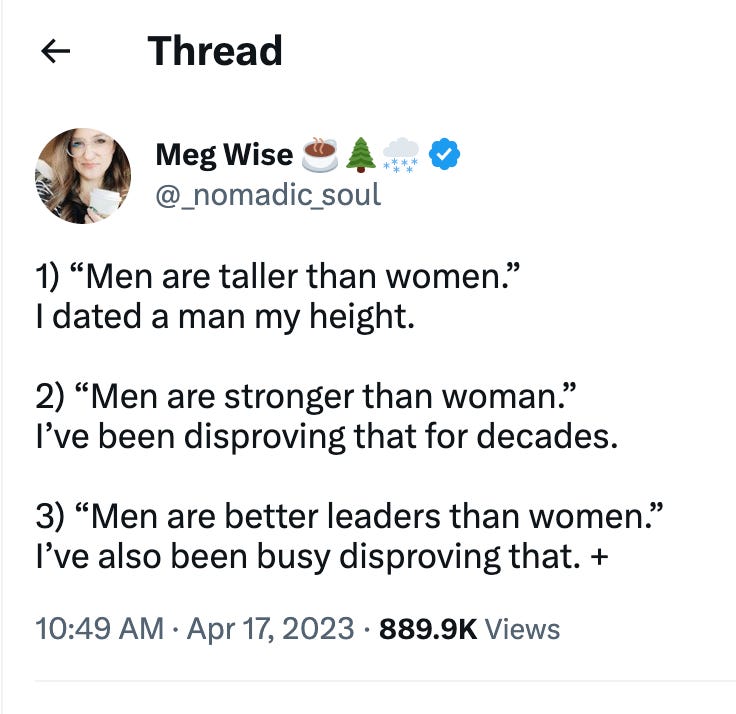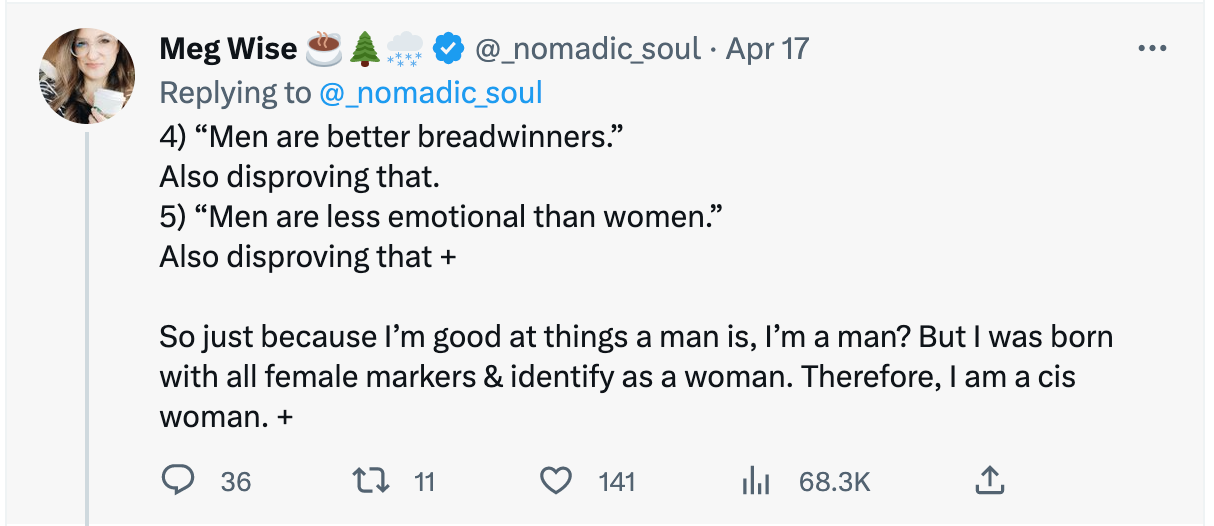Rejecting Stereotypes
Stereotypes have fallen on hard times these days. Some would say that all stereotypes are wrong because characteristics observed from the group do not always apply to every individual. Thus, they claim, stereotypes are harmful because they mischaracterize individuals. In other words, general rules are invalidated by exceptions.
Exhibit A is this Tweet thread from Meg Wise.
Notice the way she’s approaching the topic:
“Something that is generally true”
Not true! Here’s an exception that disproves the rule.
“Something that is generally true”
Not true! Here’s an exception that disproves the rule.
This is irrational thinking. Meg Wise is claiming that exceptions disprove the rule. Nonsense. Exceptions prove the rule. She gets away with it here because she’s opposing sexual stereotypes, which are the most “sinister” kind. God forbid we acknowledge any differences between men and women!
Seriously, does anyone think this way about anything else?
“Human beings have two legs.”
Not true! I know someone with only one leg!
“The sky is blue.”
Not true! The sky was rainy and grey yesterday!
See how this works? If someone wants to deny an obvious reality as normative, they can categorically reject it by pointing out exceptions.
Wise wants to deny the general fact that men are taller, stronger, better leaders, providers, and are less emotional. Feminists hate this reality and try to recruit others to their cause through this kind of sophistry. It’s a verbal sleight of hand.
Stereotyping is Pattern Recognition
That’s how stereotypes work, and stereotypes are crucial to live wisely in the world God made. What we call “stereotyping” is simply pattern recognition. Wisdom is the art of observing typical patterns, categorizing them, and drawing general conclusions from them. This is necessary to engage in any kind of rational thought. Stereotypes always have exceptions because they are, by definition, general truths. When a truth never has an exception, then it’s simply a fact, not a stereotype. Facts never have exceptions, but stereotypes always do. A society that chooses to not recognize stereotypes is a society that chooses to not see the way things are. It’s a society that cannot develop wisdom because it has chosen blindness. And we choose blindness when the truth is too uncomfortable to see.
In the modern world, the impulse towards expressive individualism is so strong that we are pressured to ignore the patterns. Whenever a stereotypical pattern is observed, someone will come along and point out an exception that is assumed to disprove the observation. Yet the differences between men and women are obvious to anyone willing to see them. Take physical strength, for example. God made men to be physically stronger than women. But in saying this, someone might object that this is an unfair stereotype because there are many strong women and many weak men. Do these exceptions make the observation unfair? Of course not. It’s a stereotype, and stereotypes always have exceptions.
The Fallacy of the Beard
Further, stereotypes rely on subjective distinctions. The lines are often blurry. This is called the “fallacy of the beard.” The fallacy of the beard gets its name from the fact that one cannot precisely define how many whiskers constitute a true beard. If you shave off one whisker, does it cease to be a beard? How about ten whiskers? One hundred whiskers? We know what beards are even though we cannot precisely identify the line between beard and non-beard. The distinction is imprecise and subjective. But an imprecise distinction doesn’t mean beards don’t exist.
We make imprecise, subjective distinctions every day. For example, when does a child become an adult? Nothing magical happens on the 18th birthday, although that’s when one is legally considered an adult in the United States. The line between adult and child is quite blurry, but that doesn’t mean the distinction is meaningless. Since there aren’t precise[p1] lines between masculine or feminine characteristics, some deny the value of any such categorizations. If a woman can be found who is physically stronger than most men, then, we are told, physical strength should no longer be considered a masculine trait. But this is illogical. Generalizations assume exceptions. That’s what makes them useful. Every day we observe clear distinctions that have blurry boundaries, such as short versus tall or rich versus poor. We need to recognize these general distinctions between men and women to live wisely with each other.
Stereotypes in the Bible
The Bible is full of stereotypes. Proverbs is considered a book of wisdom because it tells us about the way the world generally is. Proverbs observes and labels different behavior patterns, such as that of the wicked, the righteous, the fool, the poor, the friend, the ruler, the rich, the adulteress, the sluggard, and the scoffer, just to name a few. By noting behavior patterns in different kinds of people and naming them, we can learn which patterns to follow and which ones to avoid. Proverbs 15:1 says, “A soft answer turns away wrath, but a harsh word stirs up anger.” This is a general pattern. As a general rule, you can expect conflicts to go better when you speak calmly and gently. But there are exceptions. Sometimes, people won’t listen to you no matter how reasonable you are. Proverbs accounts for this, too (Prov 26:4, 5). Proverbs teaches the general rule and the exceptions to the rule. That’s how wisdom works.
Fools, on the other hand, refuse to see how the world works and try to live in fantasy land instead. By refusing to see how things really are, they render themselves incapable of attaining wisdom. Even though God has created men and women wondrously different from one another, in the modern world, it has become taboo to observe them or talk about them. This is the way of fools. But we will leave foolish ways behind and pursue wisdom instead.
Sexual Stereotypes
No discussion of sexuality can happen at all without observing what men and women are generally like and drawing conclusions about them. It’s unavoidable. For example, we cannot know what “men” are like in general without disregarding each man’s individuality to a degree, observing patterns common to most men, and drawing conclusions from the aggregated data. When closely observing human bodies and behaviors, and when these characteristics are grouped into categories we associate with masculine or feminine, we quickly find a great deal of overlap between the sexes. Almost every man will have some feminine characteristics, such as sensitivity, nurture, or compassion; and almost every woman will have some masculine characteristics, such as aggressiveness, directness, or competitiveness. Macro-level observations are not invalidated by the uniqueness of individuals. In other words, if we observe that men are generally stronger than women physically, we need not draw the conclusion that a man who happens to be physically weaker is a lesser man. Or if we observe that women are generally more sensitive than men in temperament, we need not draw the conclusion that a woman who is not as sensitive is a lesser woman. I devoted a whole chapter to discussing gendered virtue in chapter 5 of my book.
In the modern world, acknowledging differences between men and women is seen as restrictive and stifling to individual self-expression. But this has not always been the case. Other cultures around the world (not to mention in the past) have typically celebrated sexual differences by developing their own customs, forms, norms, and traditions to highlight those differences. Other cultures have been more prone to see sexual differences as beautiful, meaningful, and even liberating manifestations of transcendent realities.
Three Dangers
This doesn’t mean there aren’t some potential hazards when stereotyping men and women. I’ll note three errors in particular.
The first error is to make too much of the observations. I’m not interested in promoting unbiblical, rigid, and culturally determined gender norms. Nor do I want to bind anyone’s conscience where Christ has given us liberty (Rom 14:1-12). Sexual stereotypes are more useful in describing behavior than prescribing it.
The second error is to make too little of the observations. The patterns we observe about men and women can teach us something about God’s purpose for sexuality. We need wisdom to draw the right conclusions.
The third error is to disregard historical and cultural factors. Throughout human history, cultures have developed sexual norms and taboos to govern behavior and maintain order. For example, there is a big difference between a man wearing a Scottish kilt and an evening gown. A man in a kilt is conforming to a cultural expectation of masculinity. His kilt is part of the masculine uniform, and he wears it as part of the brotherhood of men. A skirt may be similar to a kilt in some ways, but the man wearing a skirt is signaling something different from the man wearing a kilt. He’s openly defying a cultural expectation of masculinity. By committing this taboo, he is declaring his independence from such expectations.
To be sure, expressions of masculinity and femininity can vary across time and culture, and these variances need to be taken into account, but these variations do not render the cultural expectations meaningless.
Conclusion
The biological differences between men and women are incontestable, and most of the social differences are undeniable, even if some are uncomfortable to acknowledge in the modern world. Nevertheless, we must realize that the cost of denying the manifest differences between men and women is unimaginably steep. We cannot exchange reality for fiction without yielding massive collateral damage. Trying to pretend the sexes are identical or interchangeable is like trying to level Mount Everest with a spoon. Men and women are gloriously different, crafted that way by a masterful maker.








Good post Mr. Clary! This kind of argument is what I always get when trying to communicate with other brothers that, in general, men should be physically strong. I also try to point out that being strong is not necessarily about a certain "metric" (we will not all be Navy SEALS for example), but rather about a godly attitude of using strength for the benefit of protecting and providing for family and those who are weaker. Therefore, it must be cultivated and/or maintained to some degree. Would you agree with that approach?
Thanks for writing this, brother. Looking forward to reading more.